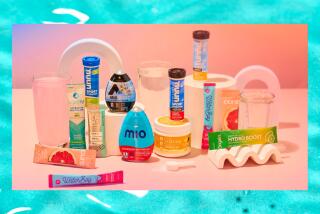As Vitamin Sales Pep Up, So Do Worries on Overuse : Health Trend Gives the Industry a Lift
- Share via
When Los Angeles Mayor Tom Bradley caught a cold early this month, he didn’t fight it exclusively with medicines or chicken soup. He also used something that tens of millions of Americans now rely on to maintain good health: vitamins.
Spokesman Fred MacFarlane said Bradley “uses vitamin C regularly” to fight colds. Still, MacFarlane added, “it doesn’t seem to have helped him; he’s had a pretty bad coldfor a couple of days now.”
Thanks to the increased health consciousness of consumers such as Bradley and recent publicity concerning the use of the mineral calcium to fight osteoporosis--thinning of the bones--the $2-billion nutritional supplement industry is poised for a resurgence after leveling off from its double-digit growth rate of the 1970s, experts say.
The popularity of nutritional supplements is especially strong on the West Coast, where a 1980 study by the Food and Drug Administration found that more than half of the population takes them.
Vitamins--organic substances required by humans in very small amounts to regulate metabolism and normal growth--first established a foothold as a popular diet regimen 30 years ago during the formative years of the baby boom generation.
Industry Grew Rapidly
But it wasn’t until Nobel Prize-winning scientist Linus Pauling published a book in 1976 claiming that megadoses of vitamin C could prevent the common cold that the industry began to grow rapidly.
Today, vitamin C is the mostly widely used supplement. It is taken daily by 35% of the population and 91% of regular supplement users, says the FDA, even though several studies published since 1976 have failed to confirm Pauling’s vitamin C findings.
“The market is showing signs that it is picking up again, and I think that in the long run it will grow tremendously,” said Edmund MacDonald, director of marketing services for Hoffmann-La Roche Inc., the nation’s leading supplier of bulk vitamins.
Demand for calcium is expected to lead to $200 million in sales next year, compared to $47 million in 1983. Children’s vitamins saw increased activity, led by the recent introduction of several new brands. And demand for vitamin C, vitamin E and beta carotene remain strong, MacDonald said.
Overall supplement sales have doubled to nearly $2 billion in the last seven years. And a 1984 study by the prestigious SRI International marketing research firm in Palo Alto predicts that the industry will reach nearly $10 billion in retail sales by 1990.
For a nation whose citizens don’t seem to have the time or the discipline to always eat a balanced meal, the popularity of vitamins and nutritional supplements would appear to be an encouraging trend. A 1978 Agriculture Department survey, for example, found that at least 20% of the population gets less than the recommended dietary allowance for vitamins A, C, B-1, B-2, B-6, B-12, niacin, iron, calcium or magnesium.
Yet there is evidence that fat-soluble vitamins--A and E--can actually kill when taken in large enough doses. And some doctors report that high doses of vitamin B-6 can produce adverse reactions such as numbness, difficulty in walking and tingling of the hands.
Scientists are by no means unanimous in their assessments of the benefits or drawbacks of nutritional supplements.
Some researchers are concerned that spectacular claims of vitamin cures and a liberal government regulatory environment have encouraged some manufacturers to become overzealous.
“There is little substantiation of the need for vitamin or mineral supplements,” said Walter Glinsmann, chief of clinical nutrition at the FDA. Yet “the law fundamentally limits our regulation. . . . By preventing the FDA from regulating (the vitamin industry) on a nutritionally rational basis, it (Congress) has opened up the possibility for the industry to do essentially what it wants. The promotion of vitamin supplements is having a significant impact on our nutritional intake.”
‘$3-Billion Placebo’
“Vitamin makers are selling a $3-billion placebo,” added John R. Dorfman, editor of Consumer Reports, which published a major story on vitamins in March, decrying the heavy promotion of nutritional supplements. “There should be more vigorous enforcement of the industry.”
Nevertheless, many women are swallowing vitamin B-6 to treat premenstrual syndrome; herpes sufferers are taking L-lysine to head off recurrent outbreaks; runners seeking endurance are swearing by a non-vitamin nutrient called B-15; zinc is said to boost the body’s immune system, and nearly everyone is swallowing vitamin C, which has been touted as cure for everything from the common cold to cancer.
That the selling of vitamins could spark such controversy is perhaps not surprising. The 13 known vitamins and another dozen or so minerals essential to maintaining good health come essentially free of charge in a balanced diet.
Marketing such a naturally available product might seem a tough sell. Yet an impressive list of companies spend millions of dollars annually to convince consumers that they need supplements as nutritional insurance.
Sellers include major pharmaceutical companies such as Squibb Corp., Warner Lambert Co., Bayer AG’s Miles Laboratories Inc. and American Cyanamid Co.
Among their competitors are more-aggressive concerns such as the direct sales nutrition company Herbalife International of Los Angeles and Pittsburgh-based General Nutrition Corp., which runs a nationwide chain of health-food stores selling vitamins, diet aids and food supplements.
Lackluster Performance
None of the manufacturers would agree to release sales or profit figures for their vitamin products. However, the performance of some of the publicly held vitamin companies has been lackluster recently.
Average sales of General Nutrition’s 1,300 stores, for example, were down $7,500 to $280,000 for the fiscal year ended January, 1985. But companywide sales, which include mail order business, rose 3% to $390 million.
Still, the tiny pills can generate better-than-average sales and profits, analysts say.
Vitamin sales average $10 a square foot per week, according to Drug Topics, an industry trade magazine.
That’s better than hair- and skin-care products and far better than overall grocery store sales, which average only $8 per square foot per week.
“I’ve seen multivitamins priced as high as $13 a bottle,” said Oleh Denysyk, a pharmaceutical analyst for the industry research firm Charles Kline & Co. in Fairfield, N.J.
Estimating that profit margins on retail vitamin sales run between 35% and 50%, Denysyk added: “You can’t put too low a price on these products because people will think they are ineffective.”
There is little chance of that impression gaining credence among consumers, given the huge marketing war being waged.
Miles Laboratories, which holds 30% of the children’s vitamin market, spent $9 million to advertise Flintstones and Bugs Bunny children’s vitamins in 1984, according to Advertising Age, compared to $17.2 million for the company’s principal consumer product, Alka-Seltzer.
That same year, American Cyanamid’s Lederle Labs spent $15.3 million to promote its vitamin products and increased spending for one brand--Centrum--19% to $10.7 million, according to the magazine.
An early beneficiary of the spending seemed to be the children’s vitamin market.
Sales climbed 10% in 1984 as manufacturers introduced a number of new vitamins brands tied to popular characters such as Squibb’s ET and Bristol-Myers Co.’s Smurfs brand. But the sales surge may be short-lived. Kline & Co. estimates that sales fell 8% to 10% in 1985.
Manufacturers Optimistic
Nonetheless, manufacturers remain optimistic about overall long-term sales growth because they believe the popularity of calcium supplements may produce a ripple effect of increased demand for other supplements.
To position itself to reap the benefits of calcium’s new-found popularity, Miles Laboratories Inc. reformulated its One-a-Day multivitamin about 18 months ago to include the mineral in a new product called One-a-Day Within.
Sales of Within have increased 15% to 20% compared to the sales of regular One-a-Day vitamins, Miles officials said. In addition, a BioCal calcium supplement specially marketed to physicians to prescribe to women patients, is “doing better than expected,” said Stephen Reim, vice president of marketing at Miles.
“It would make sense that if someone became interested in calcium supplements they would take a look at other (supplements) when they came in the store to buy,” said Bob Bidlingmeyer, group product manager for Miles.
Consumers, however, may find it difficult to determine whether and how to best use nutritional supplements, because the scientific community has become hopelessly hamstrung over the dosage levels Americans should take.
The National Academy of Sciences has revised the recommended dietary allowances every four or five years since 1941.
The academy announced late last year that it had reached an impasse with a scientific panel formed to propose changes in the suggested intake of certain vitamins and minerals, and therefore would not be immediately issuing revised guidelines.
Guidelines Vary Widely
The guidelines that exist, can vary widely: The Canadian recommended dietary allowance for zinc is 9 milligrams, for instance, but it is 15 mg in the United States.
“There may be a public health need for people to take vitamin supplements but we don’t really know,” said Bonnie Liebman, director of nutrition of the consumerist Center for Science in the Public Interest in Washington.
“Most of the studies have focused on how much of a vitamin is needed to prevent a nutritional deficiency like vitamin C (for) scurvy,” Liebman said. “Only recently have we looked at what higher amounts may do, and all the evidence is not in.”
As vitamin use grew in the 1970s, the FDA launched a bid to strengthen its regulatory control over the vitamin industry under a controversial proposal that sought to classify as a drug any vitamin or food supplement containing more than 150% of the recommended daily allowance.
The agency was rebuffed after lawmakers were deluged with more than a million letters from irate voters, and Congress passed amendments in 1976 preventing the FDA from classifying certain vitamins as drugs.
However, state authorities and the Federal Trade Commission, which regulates advertising, have taken action against some vitamin marketers who have suggested that their products can help fight everything from psychological stress and underdeveloped muscles to the common cold and cancer.
Producer Paid Fine
In December, Squibb, without admitting any wrongdoing, paid New York State $15,000 and agreed to modify the claims made on its vitamin packaging.
Squibb had been claiming that Theragran Stress Formula helps relieve stress resulting from “the complications of life,” said Squibb spokesman Bob Laverty, who declined to comment further on the agreement.
Herbalife, which reported 1984 revenue of $500 million from the sale of vitamins, food supplements and diet products, was sued last year by the California attorney general.
The suit claimed that Herbalife made false medical claims about some of its products and employed an illegal pyramid-type scheme to market them.
Herbalife officials, noting that none of the attorney general’s allegations have been proven in court, have defended their products as harmless and argued that customers are satisfied.
The company has also been cited in Canada for 24 violations of that country’s Food and Drug Act.
Most manufacturers, however, have been content to simply urge consumers to use nutritional supplements to guard against possible deficiency as a result of not eating correctly or undertaking some activity that may create a vitamin and mineral shortage, such as dieting or smoking.
An advertising flyer from General Nutrition, for example, advises consumers: “It would take a computer and a good deal of conscious effort to devise a diet that each day would give all the nutrients in optimum amounts . . . from the viewpoint of . . . nutrition, a complete supplement may be the best possible buy in health insurance.”
But some nutritionists aren’t certain that even that advice is reasonable.
Joan Gussow, a nutrition professor at Columbia University’s Teachers College and a former member of the National Academy of Sciences’ Committee on Diet, Nutrition and Cancer, said scientists are in wide disagreement over the value of nutritional supplements.
“The difficulty is that the issue of using supplements has not been dealt with seriously,” she said. “Many people may be wasting their money on vitamins . . . we don’t really know.”
The issue may remain up in the air for some, but not for one industry official, for whom the options are clear.
“Personally, I’m not going to wait for the scientific community to arrive at a judgment about vitamins sometime in the year 2000,” said MacDonald of Hoffman-La Roche.
“What fuels consumers’ demand for vitamins is the very strong belief that they may not be eating a balanced diet, and some of the dietary research being made public indicates they are probably right.”
More to Read
Inside the business of entertainment
The Wide Shot brings you news, analysis and insights on everything from streaming wars to production — and what it all means for the future.
You may occasionally receive promotional content from the Los Angeles Times.










